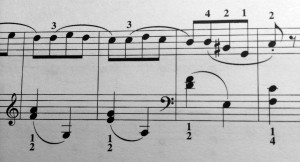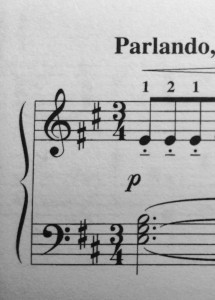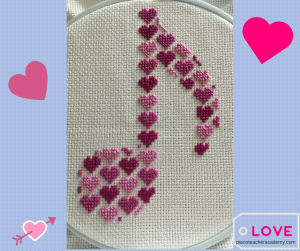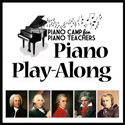Bartok, For Children Vol. I, Play-Along: Post Four (Nos. 21 – 25 Reaction)
This was an interesting set. I noticed some characteristics that I haven’t seen or heard before in the previous selections. Disclaimer: Please know that I do my best to find the better YouTube renderings of the pieces from this volume. I often don’t have much of a selection to choose from and must default to whatever I consider the best available at the time.Quick-scan observations about Nos. 21-25 :
- All pieces are EI to I (Early Intermediate to Intermediate) in level.
- Several of the same musical characteristics from his earlier pieces are evident here, but some of these seemed a little more unusual in tonality, tempo, or structure.
- There is more LH involvement in this set of pieces.
Scroll to 1:29 in this video:
Impressions While Playing: It sounds and feels “robust,” doesn’t it? It certainly packs a punch in such a short amount of time. This is one of his more popular pieces from Vol. 1 and it serves as the 2nd half of the previous “Drinking Song” (No. 20). Did you notice all the explicit fingering guidance Bartok provided? Wow. I enjoyed hearing Gyorgy Sebok’s recording in the video above. It’s a steady performance with excellent clarity and I especially liked the change of texture you could hear with the addition of the pedal in mm. 17 – end. I had the pleasure of meeting Mr. Sebok when I taught at UW-Madison long ago. He came to give a recital (a VERY long one!) and a master class. He was such a delight and a very generous man. He gave me a photocopy of the only known photo of Bartok smiling (did you notice that Bartok never smiled in photos?) Sebok studied with Bartok and you can read a bit about him HERE.
Teaching Value: This is an excellent chord study for both hands. The texture is thick, yet it must be played quite crisply. The soprano voice in mm. 9 – 16 will need special attention especially since the overall dynamic is P and there is quite a bit of activity in the other voices.
Take Note: Did you notice how fast 138 seems? Sebok doesn’t take this tempo and I rather prefer his slower jaunt. I like Bartok’s reminder at the end for the repeat and his usual indication for the overall timing of the work.
DId you notice Bartok’s explicit fingering changes for the LH repeated notes in mm. 10-16? Precise as ever. The LH in mm. 17 to the end requires a good octave hand span and the ability to handle quick, crisp, staccato chords.
Recommended For: Students with a strong hand who can reach an octave with notes between, and those who enjoy a nice romp!
Correlates To: Faber mid-Level 4 or higher (Int.)
No. 22 – Untitled (Allegretto)
Scroll to 16:58 in this video
Impressions While Playing: At first sight I thought this appeared quite approachable and straightforward until I notice the metronome marking. Yikes! It moves at a good clip. I played it at 114 several times and was never satisfied with that tempo. It sounded much too “chirpy” and I didn’t get to enjoy the lyricism of the melody. My preference was quarter note = 100. I thought the Coda and long cadence at mm. 13 – 15 was an interesting turn as well as the pause at m. 8 on the B-natural (augmented 4th of F Major scale).
Teaching Value: This is a great piece for quick repeated-note playing in the RH within a melodic phrase. Excellent also for continuity in phrasing. Notice how the LH continually moves along as quickly as the RH, guiding the direction of the phrases forward.
Take Note: Note Bartok’s explicit indications for phrase shapes using swells (hairpin cresc. and dim. marks). In mm. 9 thru 12, the LH gets a bit gnarly here with the addition of broken chords but I really enjoyed the resulting harmonic shifts compared to the earlier LH accompaniment pattern.
Recommended For: Development of lyrical playing in a light style. Notice the grazioso and quiet dynamic levels until the arrival of the rich cadence at the end.
Correlates To: Faber mid-Level 4 or higher (Int.) — if taken at a slower tempo than indicated.
No. 23 – Dance Song
Scroll to 17:47 in this video:
Impressions While Playing: I wasn’t very pleased with the video recording which I thought needed more attention to Bartok’s two-note slurs here. This piece was also a little deceptive at first sight. When you see eighths, you expect an eighth-note tempo approximately. At the given the tempo indication (152), it was quite zippy. After playing it at 152 a few times, I rather enjoyed it and I believe a student could handle it in the long run.
Teaching Value: This is an excellent LH study in rotating intervals (wrist rotation), sort of a modern “alberti” bass. The LH really gets around and playing lightly on quick finger tips is a necessity (avoid a slouchy thumb!). I would certainly have a student learn the LH completely on its own at the intended tempo, so it may serve as a solid rhythmic foundation for the RH.
Take Note: Did you notice how quiet most of this piece is? Bartok loves to ask for especially-quiet sounds when there are more notes to play in the LH:
The explicit RH articulations require fine precision at the quick tempo. I enjoyed tossing off the brisk Vivo ending!
Recommended For: Anyone who would like to increase their LH dexterity, but also for those who would enjoy a fine character piece. Page 2 insists on spontaneity and personality!
Correlates To: Faber late-Level 4 or higher (Int.) — leaning toward LI level due to tempo and the skill required for the LH
No. 24 – Untitled (Andante sostenuto)
Scroll to 18:37 in this video:
Impressions While Playing: One of the first things I noticed what the tempo (quarter note = 79). Not 80, but 79! Details, details! I thought this was very approachable for an early-intermediate level student, except for those LARGE LH reaches in mm. 22 and 24. Did you catch those 9ths?! Fortunately I have a large hand and can play them legato, but I don’t think many children could execute it.
Teaching Value: I don’t think I’ve ever seen a piece where you can execute 2, 3, 4, and 5-note slurs! At least not in the course of only 36 measures. Most or all of the phrases in this piece pull across the bar quite consistently.
Take Note: Another fairly quiet piece with a rich ending featuring the LH (notice Bartok’s espr. marking for it in m. 31). I suggest adding dabs of pedal to longer tones for added fullness. The form of this piece is A A B A and in the final statement of the A section, note the imitation that enters the picture (mm. 25- 26).
Recommended For: More mature students, perhaps? I find this piece a bit quirky and not instantly appealing. Seems rather abstract.
Correlates To: Faber Level 3A or higher (EI) — Note: Students with small hands will have to break the LH slurs in mm. 22-24.
No. 25 – Untitled (Parlando)
Scroll to 19:30 in this video:
Impressions While Playing: While noticing how brief this piece is I caught the “Parlando” indication. I couldn’t recall exactly what it meant so I looked it up in my favorite, trustworthy musical terms dictionary (more on that later!) and here’s what I learned:
In vocal music—- in a style that approximates speech, but usually in a rapid style In instrumental music—- in an expressive, declamatory styleInteresting….
While playing, I was struck by how much this piece sounded like a recitative to me. I also couldn’t help noticing Bartok’s use of the unusual keysignature once again:
His prominent use of the C# (mm. 5 and 10) produces such an eerie Dorian color.
Teaching Value: Great for teaching a cantabile expression as if it were a recitative with its short statements and pauses. I would ask a student to tell a story using the RH as the narrative (a singer) and tell them to be sure to dwell on the fermatas, especially those plaintive C#s. They add such emotional impact.
Take Note: I would add pedal on the long held tones for sustained resonance and notice Bartok’s simile direction (m. 3) for continuation of a detached melody. Did you catch the brief shift to 2/4 time in m. 7?
Recommended For: A student who would like to expand his/her expressive qualities. The player must spin an imaginative story of sound. Requires some maturity.
Correlates To: Faber Level 2B or higher (EI)
*** So which of these did you find most interesting? No. 21 is typical of what you usually hear from Bartok. Would you consider any of the others for students?













